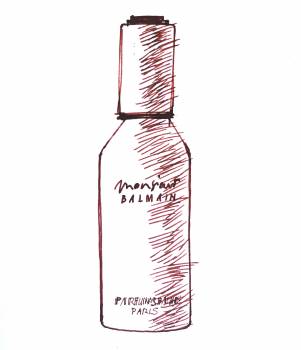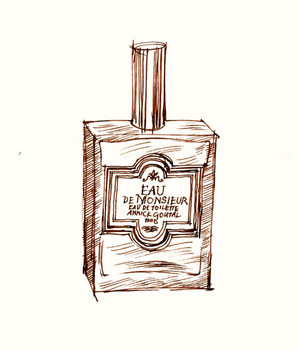Tagged With ‘lemon verbena’
Balmain
Monsieur Balmain
25 May, 2015
 Lemon verbena is not, it has to be said, the most beautiful shrub in the world, though it’s easy enough to grow in a sunny corner. Its long woody stems give it a rather ungainly appearance, with tufts of spear-shaped leaves at their ends, which appear so late in the season that I’ve often wondered whether the one in my garden was dead.
Lemon verbena is not, it has to be said, the most beautiful shrub in the world, though it’s easy enough to grow in a sunny corner. Its long woody stems give it a rather ungainly appearance, with tufts of spear-shaped leaves at their ends, which appear so late in the season that I’ve often wondered whether the one in my garden was dead.
Aloysia citrodora, to give it its Latin name, grows wild across much of South America, and like so many other garden plants it was brought to Europe by Portuguese and Spanish colonists at some point in the seventeenth century.
Though you wouldn’t grow lemon verbena for its shape, its leaves are a different matter. Long, narrow and folded neatly in half along their length, they are bright green, shiny, and rather rough and sticky to the touch. But what makes them special is the scent they release when crushed, which is so deliriously refreshing that, once I’ve started sniffing them, I find it extremely hard to stop. They make a fine herbal tea (the verveine in which Proust dipped his famous madeleine) and an even finer perfume.
As both its common and Latin names suggest, lemon verbena has a lemony scent – yet that hardly does it justice. Lemons may have a wonderfully fresh, sharp tanginess of their own, but it’s accompanied by the sour, mouth-puckering sharpness of their taste. Lemon verbena has none of that. It has all the freshness of lemon, for sure, but mixed with a gentle sweetness that never becomes cloying, however often you smell it.
This sherbety, sorbet-y scent has all the innocence of childhood: just smelling it can give me the giggles. It might not be the most sophisticated fragrance in the world, but I can think of few better pick-me-ups on a dull dark morning, or for that matter on a sultry summer’s day. And what I love about Monsieur Balmain is that it smells pretty much exactly like lemon verbena, with little else to distract your attention – and why would you want to have your attention distracted from such a delicious scent?
Perfume buffs will already know that Monsieur Balmain was originally created by Germaine Cellier, who was the perfumer behind such justly famous fragrances as Fracas, Bandit, Vent Vert and Jolie Madame. Cellier died in 1976, and Monsieur Balmain was relaunched in 1991 in a new – but apparently faithful – reformulation by Calice Becker, the creator of (among many others) Tommy Girl and Dior’s J’Adore. More recently its bottle has also been redesigned, which means that my illustration is already out of date. For once, though, the new design is classier than the old one, so all respect to Balmain (or rather to Inter Parfums, the company that recently bought Balmain’s perfume licence).
Annick Goutal
Eau de Monsieur
26 March, 2015
 Mention the name Annick Goutal and the first scent that springs to mind is Eau d’Hadrien, the intensely lemony, slightly hair-sprayish scent that was launched in 1981 and went on to become the company’s best-seller.
Mention the name Annick Goutal and the first scent that springs to mind is Eau d’Hadrien, the intensely lemony, slightly hair-sprayish scent that was launched in 1981 and went on to become the company’s best-seller.
But before Eau d’Hadrien came Eau de Monsieur. Launched in 1980, discontinued for a while and then relaunched in 2013, it shares its lemony, eau de cologne-like zest with Eau d’Hadrien, but it’s an altogether quieter, softer fragrance.
Eau de Monsieur, like Eau d’Hadrien, is based around the zesty, zingy smell of lemons and the slightly pear-drop-lemony sweetness of lemon verbena (extracted from the leaves of a straggly South American shrub).
But while that’s pretty much the start and the finish of Eau d’Hadrien, that initial burst of sharp sweet freshness quickly fades to reveal what smells a bit like a sun-drenched Greek mountainside underneath – that scent of crushed thyme, cistus leaves and lavender, which in this case has an added touch of helichrysum, that strong-smelling everlasting flower that the French call immortelle.
Immortelle isn’t a scent that everybody loves: to me it has the richness of brandy and Christmas pudding and crackling pine-log fires, but to other people it has a medicinal TCP smell, which isn’t something you necessarily want in a perfume.
In Goutal’s fantastic Sables, released a few years later in 1985, immortelle is the main ingredient, but in Eau de Monsieur it’s used in moderation to give a subtle background sweetness. According to the list of ingredients on the Annick Goutal website, it also includes patchouli and sandalwood, which add a bit of their gentle warm woodiness to the mix, and there’s a little bit of bitterness too, which other writers have ascribed to that classic men’s-fragrance ingredient, vetiver.
It’s not, perhaps, the most original perfume out there, and it’s disappointing to discover that it only last an hour or so on the skin, but Eau de Monsieur is classy, attractive, natural-smelling and easy to wear, which is a lot more than you can say for the majority of men’s fragrances.